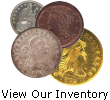The following was written by Tom:
It’s hard to feel any more patriotic than today, which is Patriots' Day here in Massachusetts. Right here in Concord Center is not too far away from where it all started in 1775 with the “shot heard round the world,” which was the start of the American Revolution. From our office window we have a birds-eye view of the annual celebratory parade. Minuteman groups along with marching bands, scout groups and more make their way along the parade route while thousands of visitors who have come from near and far, watch and celebrate the spectacle.
Speaking of history, the Caldwell family has a long history of involvement in the festivities. Back in the 1960’s I used to march in the parade as a Boy Scout. As the Bicentennial approached, my parents joined the local Minuteman group and also marched in the Concord parade. Later, my two children marched while they were involved in the Scouts.
About halfway through the parade route is the Old North Bridge, at which you’ll find Daniel Chester French’s Minuteman statue. This statue is memorialized on the Concord-Lexington Silver Commemorative Half Dollar (see below). The parade makes a ceremonial stop for speeches as well as a crowd favorite - the reenactment of the famous battle between the British and Colonists at the bridge.
Back in the day as a kid, never would I have thought Concord would become home to my family as well as Northeast Numismatics. Happy Patriots' Day!
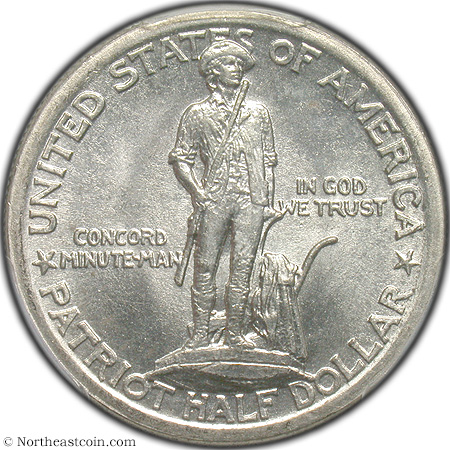
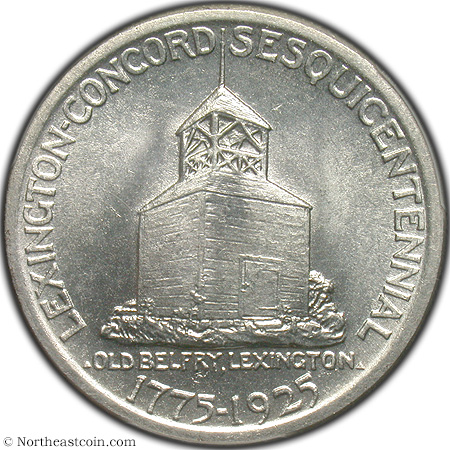
I enjoyed your piece, Tom.
Excellent! Glad you enjoyed it.
After placing a 1943 Copper Cent (PCGS XF45) last year with a customer of ours, we picked up this discovery piece (NGC AU53) earlier this year. The following is an article that appeared in the recent CPG Coin & Currency Market Review. Click the link below the blurb to read the article in its entirety.
The Mystique of the 1943 Bronze Cent Spans Time
April 5, 2019
By Joshua McMorrow-Hernandez, Editor
In the 110-year history of the Lincoln cent series, few issues have captured more six- and seven-figure prices, let alone more attention from the general media, than the 1943 Lincoln bronze cent. The origins behind this fantastic transitional off-metal error, a 1943 Lincoln cent intended to be struck on a zinc-coated steel planchet but instead manufactured with a bronze planchet used in striking 1942 Lincoln cents, are somewhat mysterious. What numismatists know is perhaps 20 or fewer bronze planchets from the 1942 run of Lincoln cents were struck as 1943 Lincoln cents, which were supposed to be struck on steel planchets to help save copper for World War II artillery purposes.
Click here to read more.
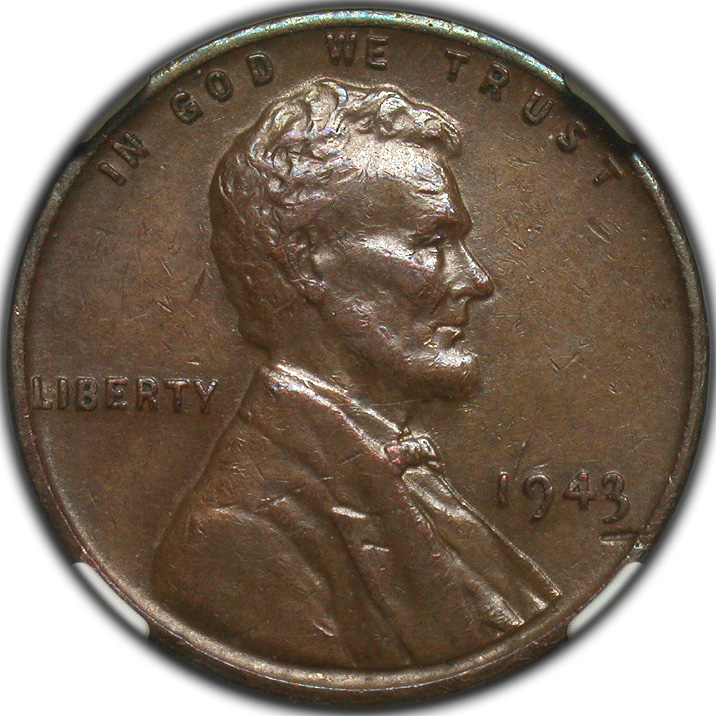
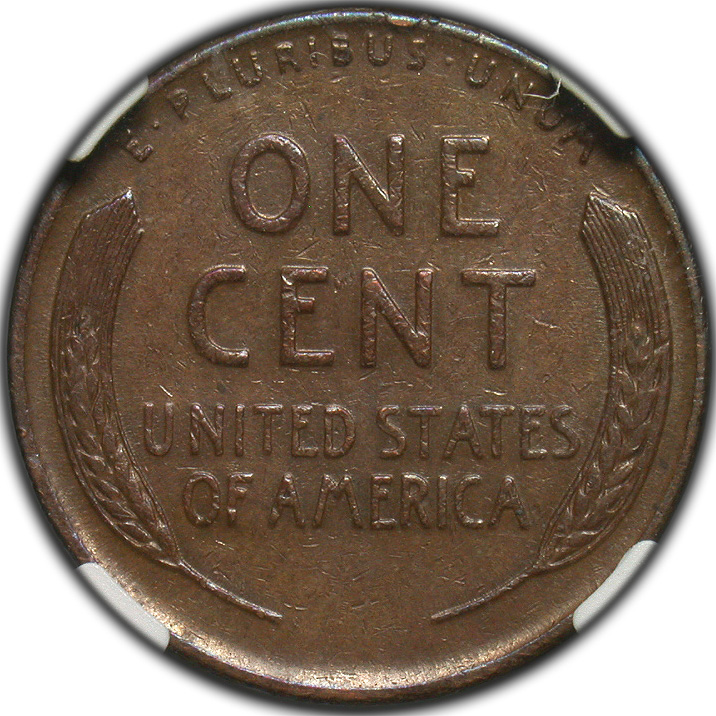
The following was written by Brian:
We have a wonderful customer named Paul from right here in Massachusetts that we have been doing business with for the last couple of years. Paul is 92 and is a spry, fiery sort. We all love him here at Northeast and hope he lives well into his 100's. Paul has been collecting for just shy of 75 years and has built an impressive collection of Lincolns, Flying Eagle Cents, Walkers and Mercury Dimes, among other types. Actually, Paul completed his Walking Liberty Half Dollar set with us.
A few months ago, after purchasing a 1942/41-D Mercury Dime from us, he proudly mentioned that he then needed only one coin to complete the set - the elusive key date 1916-D. We did have one at the time, but unfortunately for Paul it was Mint State and as you can imagine just a bit outside the range with which he was comfortable paying. He asked if we could try and locate one in Fine condition. With that, we added Paul's wish to our want list and sure enough, Tom from our office found just such a coin later that week. I called Paul and he said that he hadn’t been feeling so good lately, although he did seem to perk up when I gave him the news that we had located a 1916-D Mercury Dime NGC F12. Paul said that if he "makes it through the night" then he would call us the next day. Sure enough, we got the call the following morning and Paul was feeling markedly better and that he was ready to buy the coin and finally complete his set. He sounded like he was beaming at the prospect of finally reaching this life-long numismatic goal.
We all like stories that have a happy ending like this one, but remember, you don't have to be 92 and on your last coin in order to give us your want list. Perhaps we can make it happen for you whether you're just starting out or finishing up your collection.
Congratulations to Paul!
The following was written by Tom:
Several months ago, Ernie Botte from EBW Enterprises, who conducts very successful monthly local shows in New England, asked me if I would be interested in conducting a one-day coin grading seminar at his semi-annual regional November show in Manchester, New Hampshire. Unfortunately, the reason Ernie was asking was that Charles Browne, who would normally have done the seminar, passed away earlier this year after a long and courageous battle with cancer. We knew Charlie as a friend, fellow coin dealer, and all-around good guy for over 40 years. We grew up in the business together. He was known for generously providing his time to the annual ANA grading seminar in Colorado Springs every summer. Charlie worked for a time at PCGS as a grader and he dealt in coins, working for several dealers and himself throughout the years. A friend and mentor to many, Charlie always had a smile and a kind word. He is dearly missed by all. In his honor, the ANA has set up a program to raise funds for a scholarship for a young numismatist for every year of Charlie’s volunteer years of service. Please click here to learn more.
Having been in the business for over 50 years, I know how to grade coins. We do it every day as we evaluate and purchase raw coins in collections and spend tens of thousands of dollars annually in grading fees at the third-party grading services. In order to make good buying decisions, we need to know what we are looking at when viewing raw and certified coins alike. However, having never been a teacher, the prospect of running a class was a little intimidating to say the least. Agreeing to do so, I partnered with Dave Pepi from Pilgrim Coin to conduct a 90-minute class on the last day of the show.
The 20 or so students that awaited ranged from a 12-year-old whose birthday was that day and had asked specifically to attend this class as a gift with his dad, to a couple of local vest pocket dealers, including retirees looking to expand on their grading skills.
In advance, I made many notes to which I could refer. When the class kicked off, we explained and discussed how our grading system originated and evolved into what we use as today’s standard:
Starting in the early 20th century, grading was strictly adjectival and primarily used only Good, Fine, Extremely fine, and Uncirculated. Numerical grading then came into play when Dr. William Sheldon came up with the 1 to 70 scale in 1948, for usage primarily with large cents. In the 1960’s more intermediate adjective grades were added and came into common usage. Only in the mid 1970’s did numerical grading start to become popular. This was largely value driven. As prices were increasing, and collecting and numismatic investing became more popular, the need to further pin point grades became necessary. This was the era when the first grading service started. ANACS, which was owned by the parent organization the American Numismatic Association, started in the mid 1970’s with paper certificates showing black and white photos of the obverse and reverse of the coins. Next, NCI improved on this concept in the early 80’s with color certificates. At this time both ANACS and NCI had split grades; meaning the obverse could be MS63 and reverse MS64.
Then in early 1986, PCGS started up with NGC following in mid-1987. With the innovation of these grading services we finally had our encapsulated grading services that we depend on and universally use to this day. Other interim grades such as XF45 and AU53 were added into the lingo and became commonly used. Later, plus signs and stars on grading inserts were sometimes used for coins when deemed appropriate. Again, this was largely value driven and used for coins that were exceptional.
By this point in the seminar the students had heard enough about the history of grading and were more than ready to get down to business.
Making sure everyone had a suitable magnifier (our Northeast magnifier was handed out to anyone in need), forty certified coins were chosen from our inventory. We then placed stickers over the grades on the holders and had the eager students split up into four groups. Ten coins and a list were provided to each group to review. Dave and I then roamed around and observed their grading techniques. They were first instructed on how to properly use a magnifier. Then they learned about tipping the coin as you view it in order to take the strike and luster into consideration. Does the coin have bag marks? If so, how does this affect the grade? If the coin is toned, is the toning original? Is it ugly, attractive, or just average and how is this taken into consideration at when a final grade is arrived? Grades were then revealed, and we had a discussion on why X coin was X grade. Next, the groups of coins were exchanged with other students so that each group had the opportunity to grade a total of 20 coins.
In the end my pre-seminar notes were little used or even needed. Everyone seemed satisfied with our instruction, with many having picked up some pointers while others were perhaps still more than a bit confused, which is completely understandable. Learning how to become an expert grader does not happen overnight. Emphasis was made on looking at coins to see how they are graded. Go to shows, get confidence in your local dealer, look at auction catalogs, and look at online images (so excellent these days). The more you see, especially in person, the more you will understand about grading.
The Great Concord Bank Robbery of 1865: A Forgotten Saga of Action, Deception, and $310,000 in Stolen Securities
By Benjamin Simpson

Recreation of the robbery; photograph taken in the 1890s. Illustration from Langdon W. Moore: His Own Story of His Eventful Life.
The office of Northeast Numismatics is in Concord, Massachusetts. Concord has witnessed great battles, championed its revolutionary writers, and produced many famous politicians since the town was founded almost 400 years ago. Countless historians have written about the Battle of North Bridge, the town’s bold participation in the Underground Railroad, or other notable occurrences. But up until now, one fascinating story has remained lost to history for many years. There is a small brick building with a Doric portico located in Concord Center about a block from our office. Today it is a shoe store, but most ‘Concordians’ don’t know that 153 years ago the building was the site of one of the largest and most remarkable bank robberies of 19th century America.
The Robbery:
On two o’clock of September 25th, 1865, cashier Mr. Cheshire returned to the Concord National Bank after his lunch break to discover that the safe key was missing. Immediately assuming the worst-case scenario, he closed the bank, calmly informed the town police, and telegraphed bank president George Heywood in Boston.
It took six hours for Heywood, who had a second key, to return to Concord by train and unlock the safe. When he did, the group of officers and bank officials who had gathered under candlelight discovered the safe had been cleaned of the $310,000 in bonds and paper money it contained, equivalent to approximately $5 million today when adjusted for inflation. A valuable silverware set belonging to one of the churches in Concord was also missing.
The robbery shocked Concord and the nation. As a cost-cutting measure, both banks in town, the Middlesex Institution for Savings and the Concord National, shared the same vault. The thieves had effectively robbed two banks at once. There was no FDIC or deposit insurance back then, and until the money could be recovered, anyone who had a bank account in Concord was left with nothing. Records show that famous Concord writer Ralph Waldo Emerson did his banking at the Concord National during the time of the robbery. The New York Times published an article on the 26th of September announcing the robbery, and the story was in the Chicago Tribune by the 27th. Flyers listing the stolen bonds and currency, like the one illustrated below, were quickly circulated throughout New England with the hope that somebody would identify the serial numbers of the stolen bonds. A $20,000 reward was posted by Heywood for “the recovery of the stolen property or conviction of the thieves.”
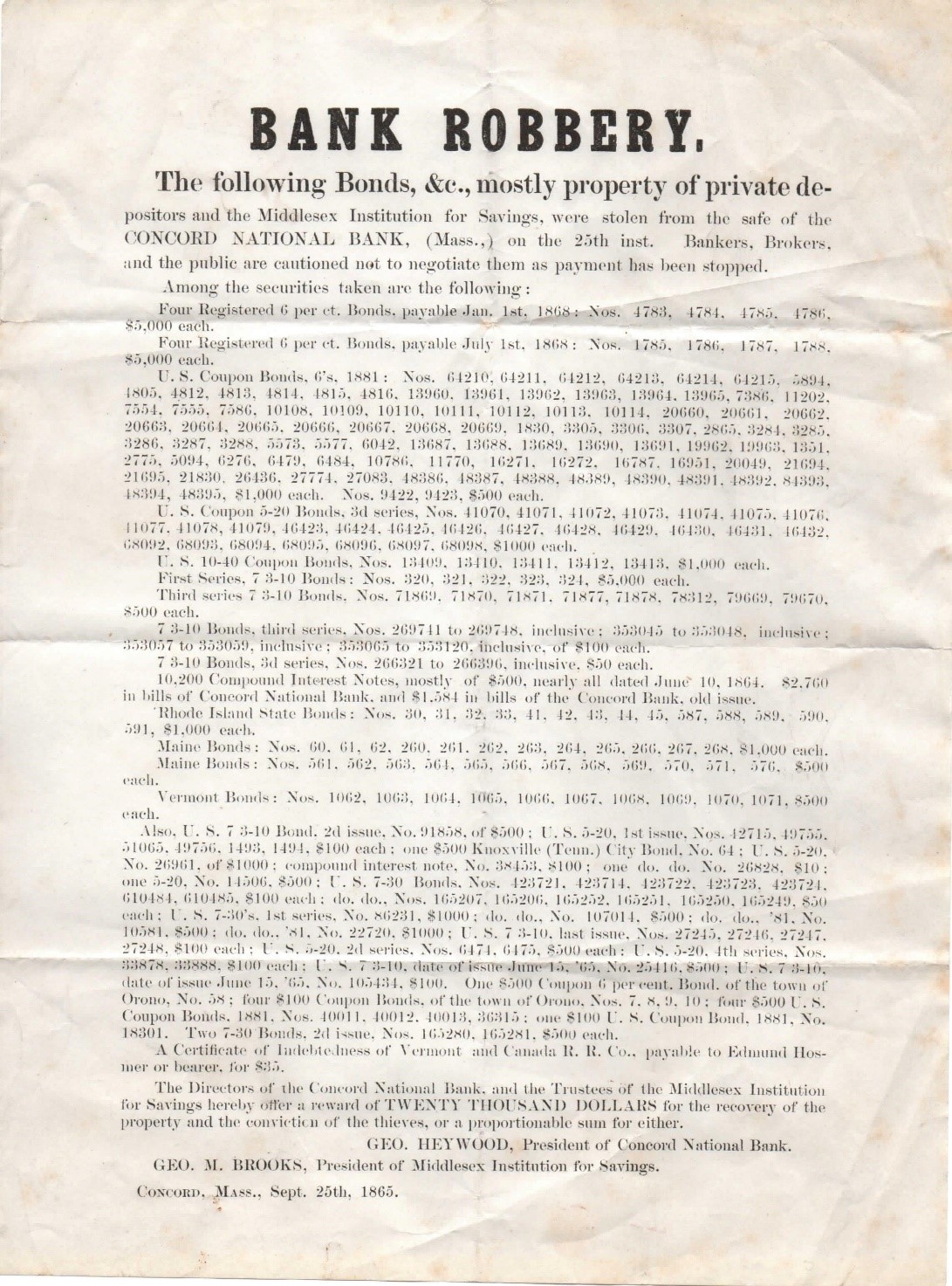
“Bank Robbery” poster printed only a few days after the robbery, listing the serial numbers of the stolen bonds and announcing a $20,000 reward for their return. Author’s collection.
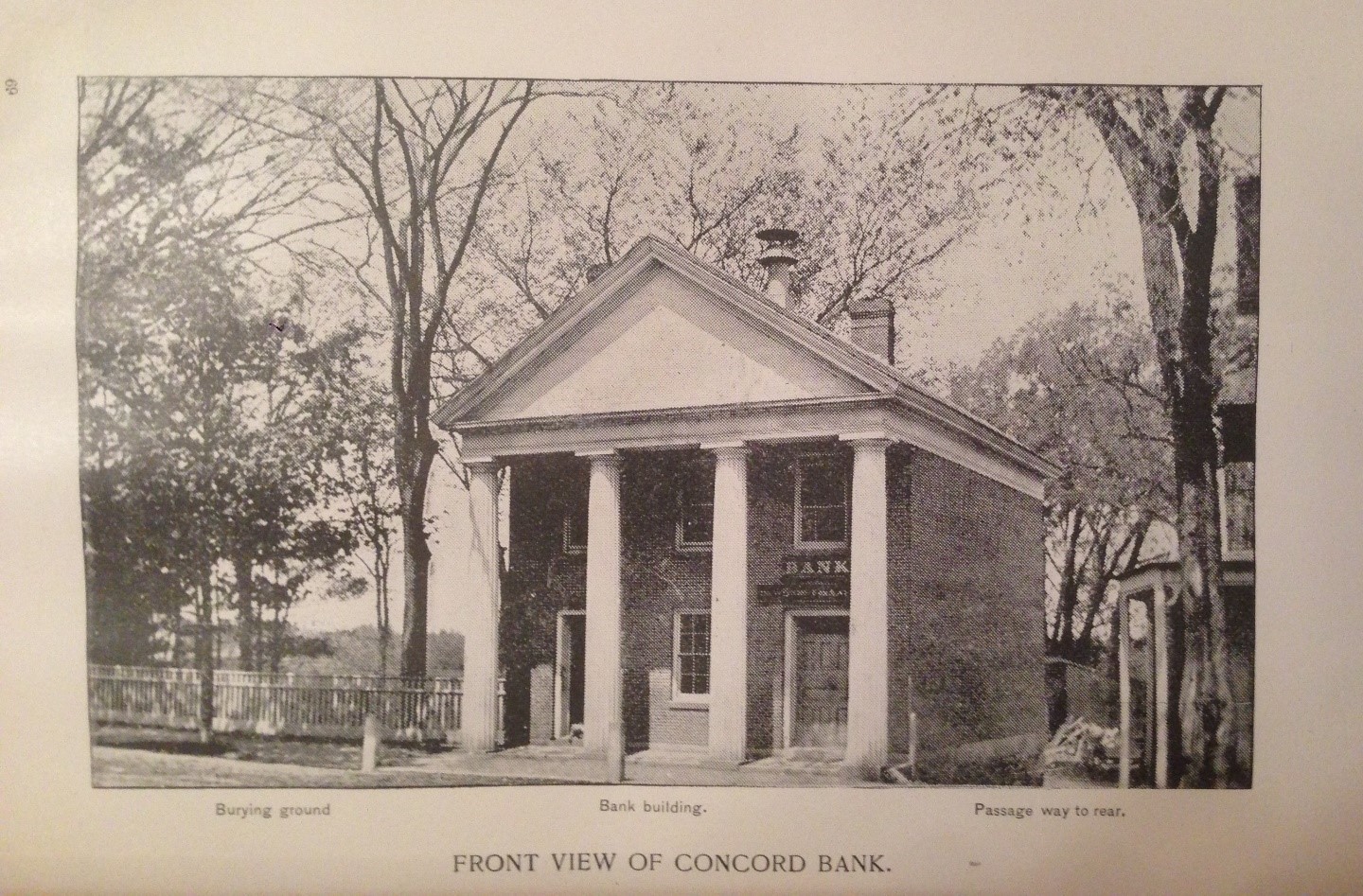
The Concord National Bank building, built in the 1830s and seen here in the 1890s. Illustration from Moore’s book. Langdon W. Moore: His Own Story of His Eventful Life.
Detectives originally thought that the robbery was an inside job because none of the locks on the doors or the safe had been broken, but Heywood insisted that all his employees were loyal and above suspicion. There was only one witness. A 12-year-old girl, the cashier’s niece, visited the bank shortly after noon. She saw a stranger inside who told her the bank directors were in session and could not be disturbed.

Window from the old Concord National Bank building. Currently in the Concord Museum collection. Photo courtesy of David Wood.
With a $20,000 reward being offered (worth over $300,000 today), every police department in the country was hunting for a lead. After about a month of waiting, the policemen in Fitchburg made a breakthrough for the case. Charles O. Brockway, the boss of a gang of counterfeiters, was serving out his sentence in the Fitchburg Jail when he received news of the robbery. Brockway made a deal with the authorities to reveal the names of the robbers in exchange for his freedom and one thousand dollars cash, provided that the information was accurate.
Brockway told the investigators that Langdon W. Moore and Harry Hunt, currently living in Framingham, had robbed the Concord National Bank. He knew it was them because he had worked with Moore and Hunt in the past, and upon learning their whereabouts, Brockway understood that their visit to the area at the time of the robbery was not a coincidence.
The Thieves:
Langdon W. Moore was tall and well-built. He always wore elegant attire and behaved like a gentleman. When people saw him, they often thought he was a wealthy merchant or retired banker. Indeed Moore was wealthy, but his true occupation was much more exciting. Moore was, at various times in his life, a gambling hall owner, a manager of a counterfeiting ring, and a professional bank robber. Unlike most criminals of his day, Moore never carried a gun, and he never intentionally robbed from the poor. He did, however, always carry at least a thousand dollars of cash on his person.
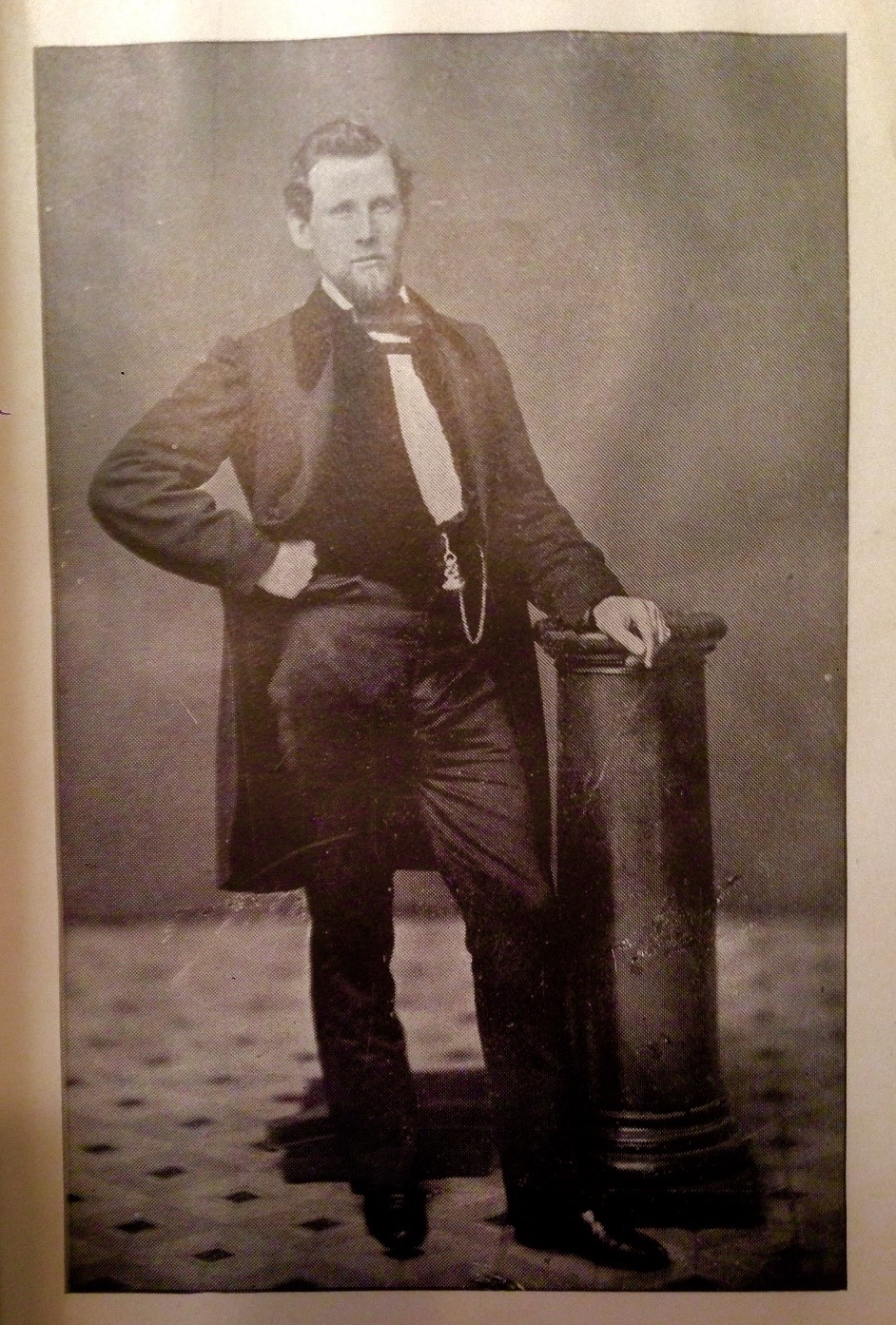
Portrait of Moore taken in the late 1850s or early 1860s, New York. Illustration from Moore’s book. Langdon W. Moore: His Own Story of His Eventful Life
Moore was born in the town of East Washington, N.H. during 1830. He spent his boyhood in Newburyport, Mass. and worked as a farmer’s assistant. When he was sixteen years old, Moore moved to Boston so he could earn higher wages. He became a cashier for various businesses, including his father’s grocery store in East Boston. After losing all his savings during his first experience gambling, Moore moved to New York City, where he made a living by playing poker in underground gambling halls.
During the 1850s, a private bank could issue their own paper money if they had enough gold on hand to cover any redemptions. These banknotes circulated freely, and often one bank would accept the notes from another at full value. Moore began to meet banknote counterfeiters while gambling in New York City. These counterfeiters would print fakes of a certain bank’s issues and quickly trade them in before the authorities caught on to the fakes. Moore began working as a counterfeiter, and by the late 1850s he ran a large New York counterfeiting operation. Moore was very good at printing fakes, and he hired about a dozen people to redeem them for him.
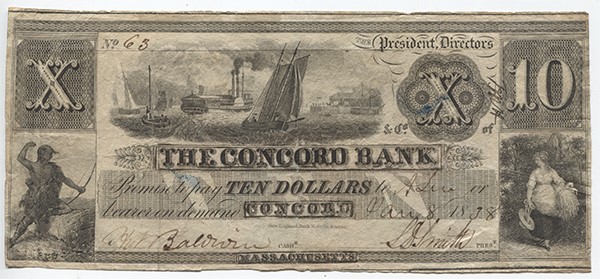
Ten-dollar Obsolete banknote from the Concord Bank in Massachusetts (would later become the Concord National Bank), 1838; obsolete notes like these were the type that Moore and his partners counterfeited. Several thousand dollars of them were stolen in the robbery. Tom Caldwell’s collection.
Moore made a lot of money from his illegal activities, but one of his closest accomplices was arrested in late 1864, and the police were close on his trail. That was when Moore decided to sell the gambling house he had been operating, abandon his counterfeiting venture, and buy a farm in Natick, Mass. until things cooled down in New York. He brought several of his cronies from New York with him, who, being total strangers to the local police, successfully posed as farmhands.
With nothing to do in Natick during March of 1865, Moore planned to rob a bank. He taught himself how to pick locks and practiced breaking into a safe that he had purchased. Moore originally planned to rob a bank in Francestown, NH, but he decided not to because he knew some people who lived nearby. On the way back home from Francestown, Moore stopped for lunch in Concord and visited Concord National Bank. There, he exchanged a $100 note for twenties, carefully observing the cashier as he unlocked the front and inner doors of the safe to make change. It was an older model from the 1830s that Moore knew how to break into. Moore had found his bank; he partnered with an Englishman named Harry Hunt, an expert safe cracker and lock picker, and they began planning the robbery.
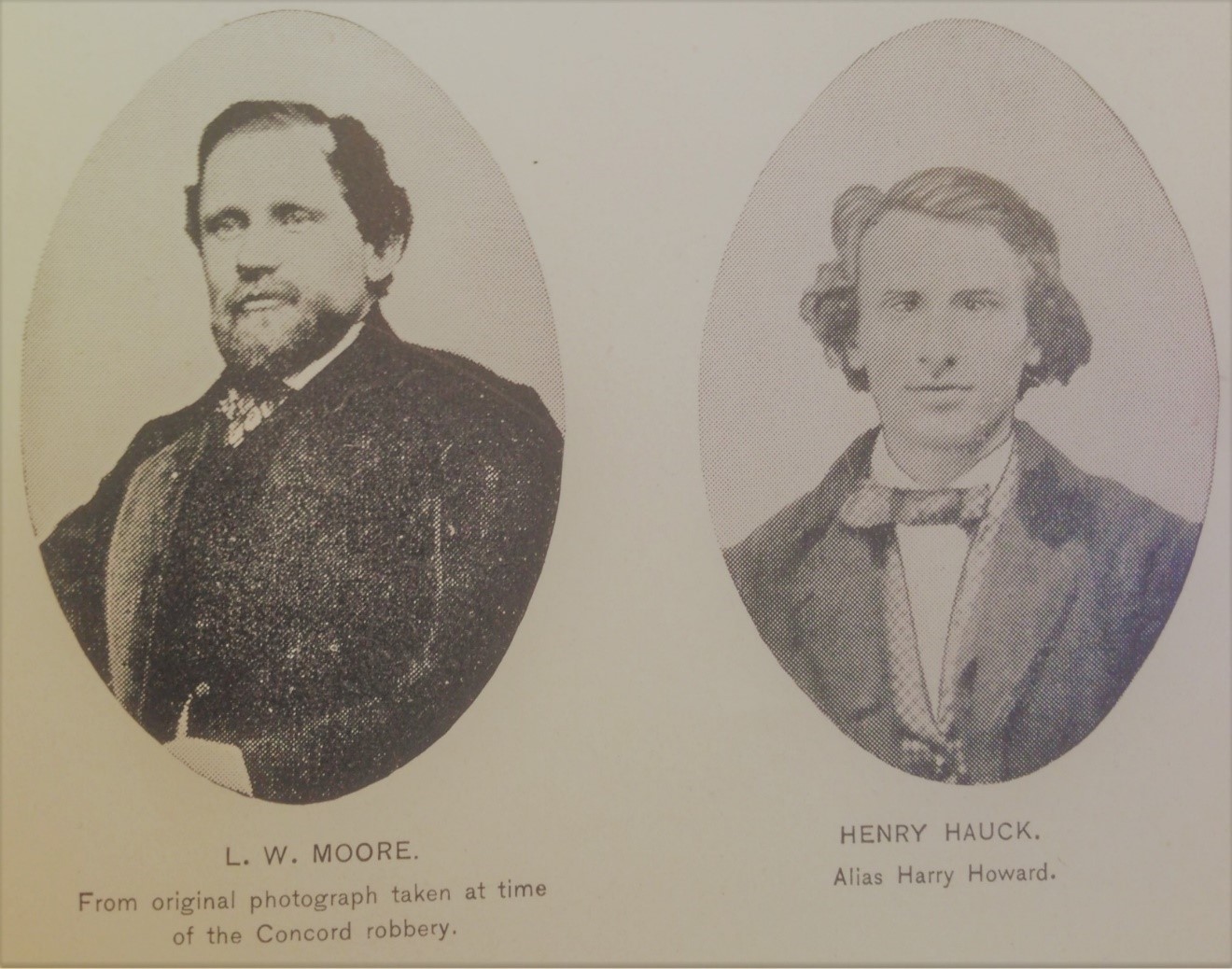
Photographs of Langdon Moore and Harry Hunt around the time of the robbery; illustration from Moore’s book. Langdon W. Moore: His Own Story of His Eventful Life.
The two men visited Concord late the next night, watching the bank and taking note of any movement that occurred in town. This was the first of many times when they returned in the dead of night. They started by creating a mold of the lock on the front door. Next, they made a mold of the lock on the bank’s second door, and then they began with the ten locks on the outer and inner doors of the safe. Night after night, they would secretly visit the bank, enter it, and laboriously mold the locks. The visits got so regular that Moore and Hunt began to store tools behind the very vault they were robbing. They had several close calls, including one time when a chamber pot was emptied on Moore in the alley next to the bank and another when Moore accidently dented the front door. The damaged door would have surely alerted the cashier if Moore had not wedged the pieces of wood back into place. However, despite some close calls, their daring persistence paid off. After five weeks of nightly visits, Moore and Hunt had a complete set of keys for the bank, and the two burglars could steal the contents of the vault whenever they wished.
Moore waited to make his move until the afternoon of September 25th, when he knew the bank would receive a large delivery of bonds worth $75,000. Hunt sat across Main St. in a stagecoach while Moore strolled through the graveyard next to the bank, pretending to read the epitaphs on the headstones. Once the cashier closed the bank for lunch and walked home, Moore used his set of keys to enter the front door. He proceeded to unlock the second door and the vault doors with ease. Aside from the incident with the cashier’s niece, the robbery went smoothly. Nobody noticed the formally dressed man wearing a top hat low over his face as he casually walked away from the bank with an old burlap farm bag over his shoulder. Moore lighted a cigar, strolled down to where Hunt was waiting for him, tossed the bag into the back of the stagecoach, and said, “All right, Henry. I guess we can go home now.” Everything had gone according to plan. Back at the farm, Moore sold the carriage and shot the team of horses that had been used in the escape, thus hiding all evidence of the robbery. He even prepared an alibi in case the police caught on. Right after he returned from the robbery, Moore sent for a doctor. The doctor came, observed Moore (who was genuinely sick at the time), and prescribed him some fever medicine. Moore began to laboriously edit the serial numbers on the bonds so they could be redeemed. He gave Hunt his 1/3rd cut of $103,000, who subsequently departed.
The Chase:
The police were quick to pursue the lead Brockway had given them. They were delayed in obtaining a search warrant for Moore’s farm in Framingham, but investigators surrounded it anyway, discreetly examining Moore’s every movement. After spotting a policeman hiding in the woods, Moore quickly sold the farm to his brother and left for New York to avoid arrest. However, the New York Police Department began spying on his apartment and following him through the streets. Another one of Moore’s accomplices turned on him, and the New York police had enough evidence to bring him in. Moore left New York and purchased a farm in Paulsboro, New Jersey (ten miles south of Philadelphia) to escape arrest once again. There, he hid the stolen bonds under a pile of manure in the barn.
On January 23, 1866, five months after the robbery, Moore was peaceably arrested by the New York Police Department at his farm in New Jersey. The detectives thoroughly searched his property for the stolen money, but in an act of astonishing good fortune for Moore, they failed to locate the hidden sack of bills. A few days later, several bank officials from Concord made the train ride down to New York to negotiate with Moore. With all the money still missing, they were left with no other option but to agree not to press charges if Moore returned the funds. The $203,000 in securities was repaid, and Moore never had to serve a day in prison. The stolen set of silverware was also returned to the Concord minister, and Moore claimed that had he known whom it belonged to, he never would have taken it.
The Conclusion:
Langdon Moore would continue to lead a life of crime for another thirty years, robbing banks and stealing valuables. The Concord robbery cemented his reputation as a highly skilled burglar. He served out two sentences for other crimes, one of which was coincidentally served at the Concord State Prison about three miles from Concord Center. As an elderly gentleman in the 1890s, Moore reformed from any illegal activities, wrote a 650-page autobiography describing his exciting life of crime, and began giving lectures. He dedicated three chapters to the Concord National Bank robbery, the first and largest of the many bank robberies that he committed. These chapters have proven to be an invaluable resource for me in retelling his story. On a side note, Moore was a coin collector. While I was unable to discover any details about the coins he had, Moore says in his book that he owned “$100 face value in rare old coins” at the time of the Concord robbery. Moore lived out his days in New Jersey, where he passed away in 1910 at the age of 80. Although he was quite well known during his lifetime, Moore’s story is all but forgotten today.
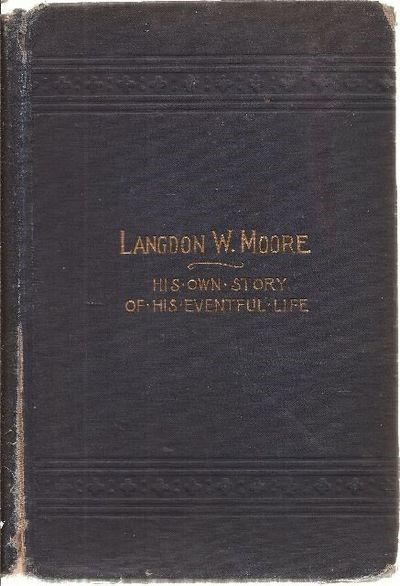
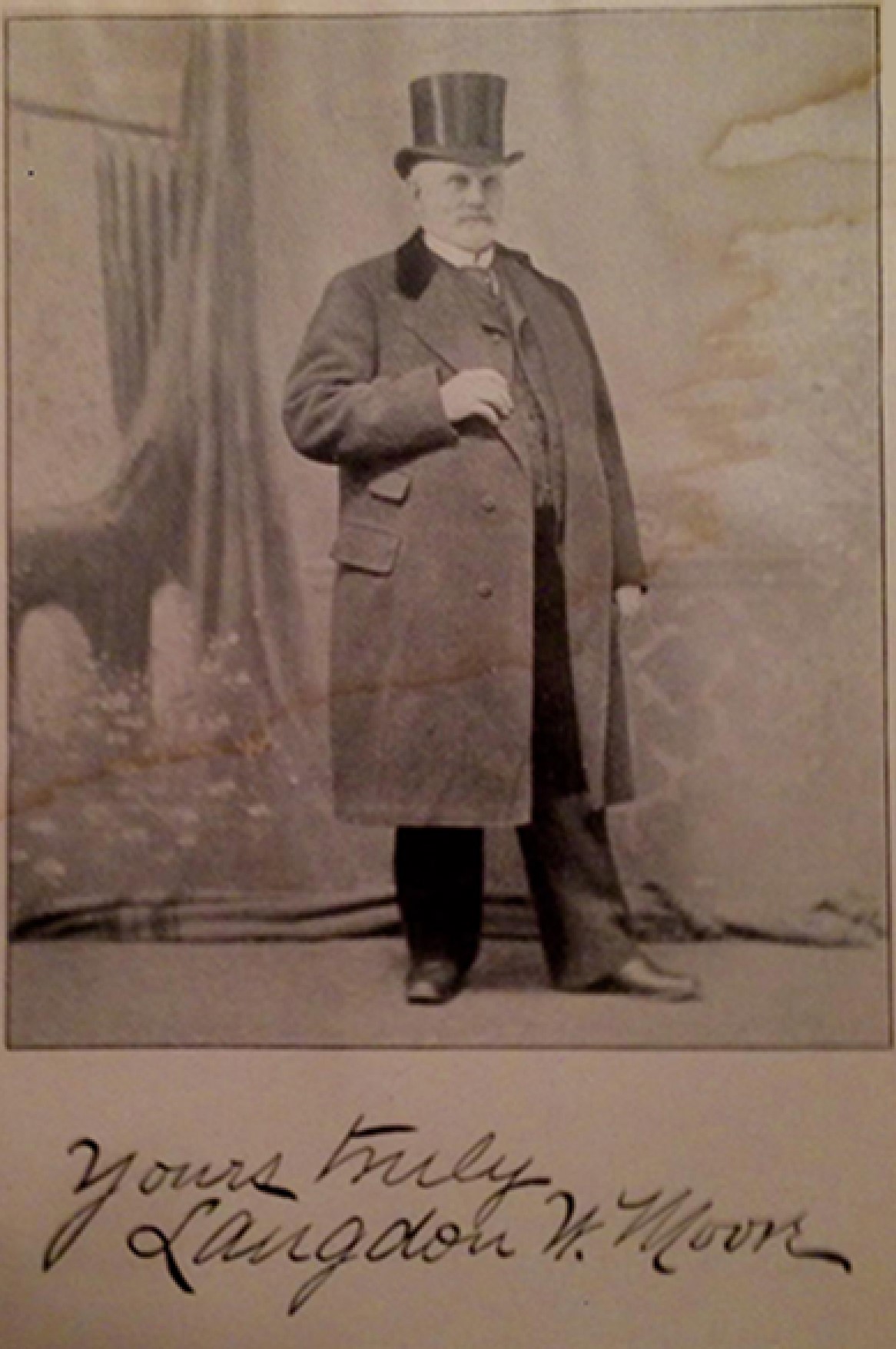
Moore’s 650-page autobiography and a portrait of him taken at the time of publishing in 1892. Author’s collection.
As for the English safe-cracker Harry Hunt, we will never know his fate. He split from Moore after the bank robbery. One Boston newspaper hypothesized that Hunt took a steamer to Germany, were he could have sold the bonds without being caught. Alternatively, he might have returned to his native England or perhaps traveled north to Canada. None of his $103,000 share was ever recovered, but neither the Concord National nor the Middlesex Institution for Savings folded from the loss.
The Concord National Bank thrived under the leadership of President George Heywood after the robbery, and his son, Charles Fay Heywood, expanded the bank in 1915 by building a larger and more modern structure next-door at 52 Main St. (today a Bank of America branch). George M. Brooks, the president of the Middlesex Institution for Savings, was elected to the U.S. House of Representatives in 1869. He resigned in 1872 and served as judge of probate in Middlesex County until his death in 1893. Unhindered by the robbery, The Middlesex Institution for Savings would grow out from its single location in Concord to become Middlesex Savings Bank, and it currently operates 22 branches across the county.
As one unnamed journalist noted in the Boston Daily Advertiser after Moore had been arrested, “The same amount of energy, industry, and shrewdness, employed in any reputable way, would have surely brought [the robbers] the wealth they coveted, without the crime or the risk.”
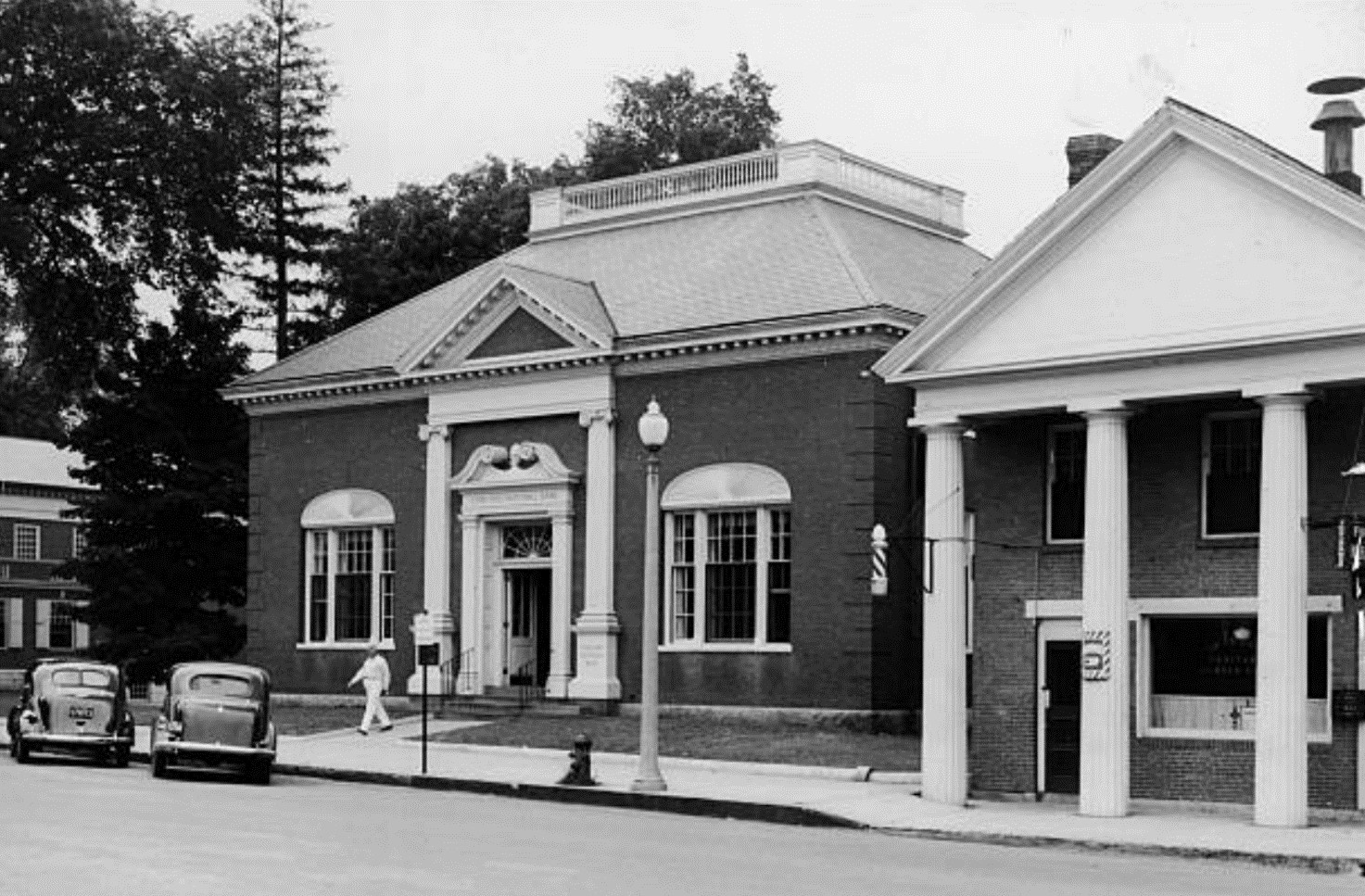
The second Concord National Bank building in the early 1930s, today a Bank of America branch. The old bank building on the right became a barber shop.

Ten-dollar Concord National Bank note, early 1930s; notice the signature of C. Fay Heywood as cashier. Author’s collection.
Additional Illustrations of Concord: Then and Now
While the clothing, cars, and businesses have changed in Concord center over the past 100 years, many of our buildings have remained the same.
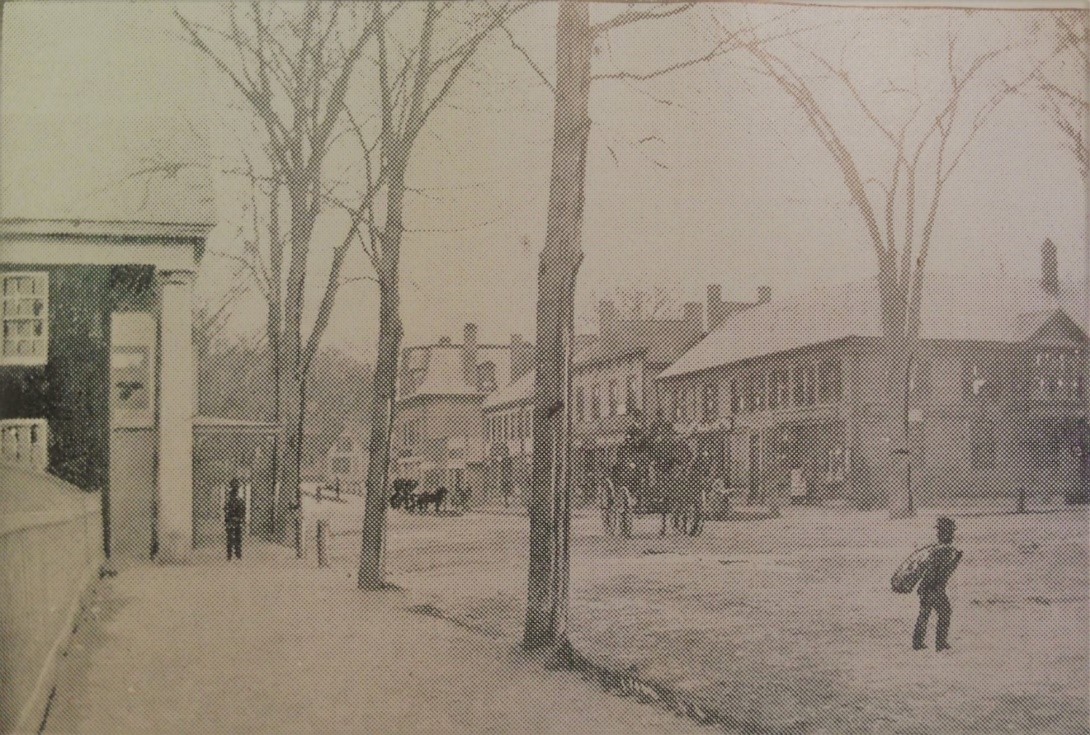
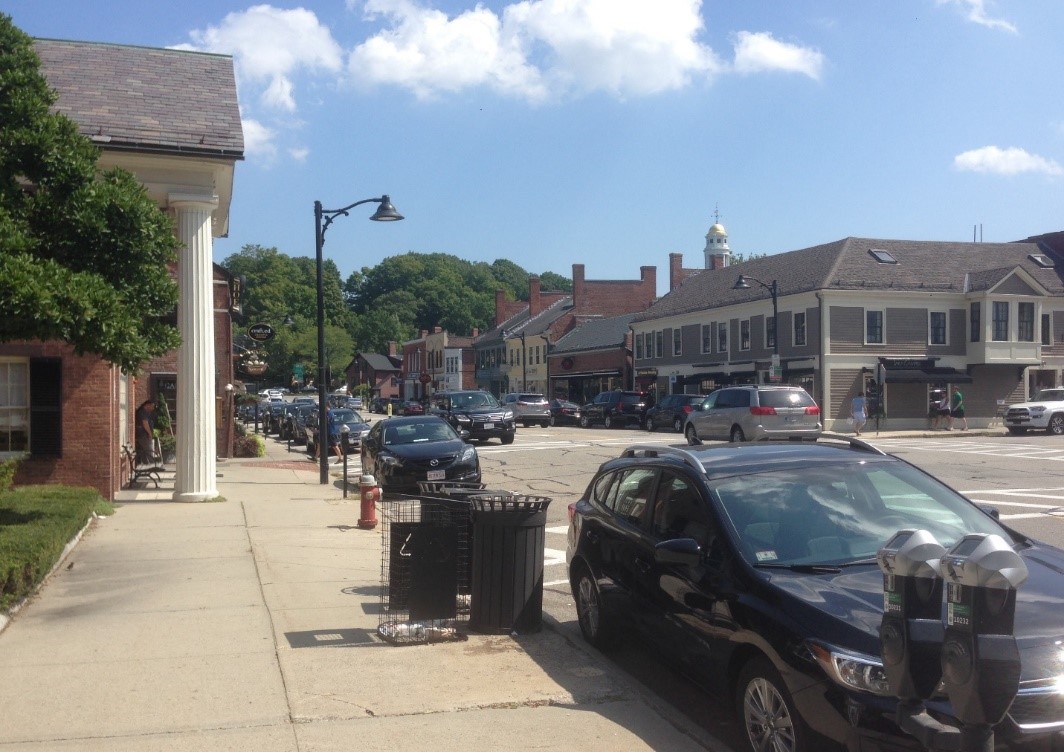
Main St., looking East, during the 1890s vs. today.
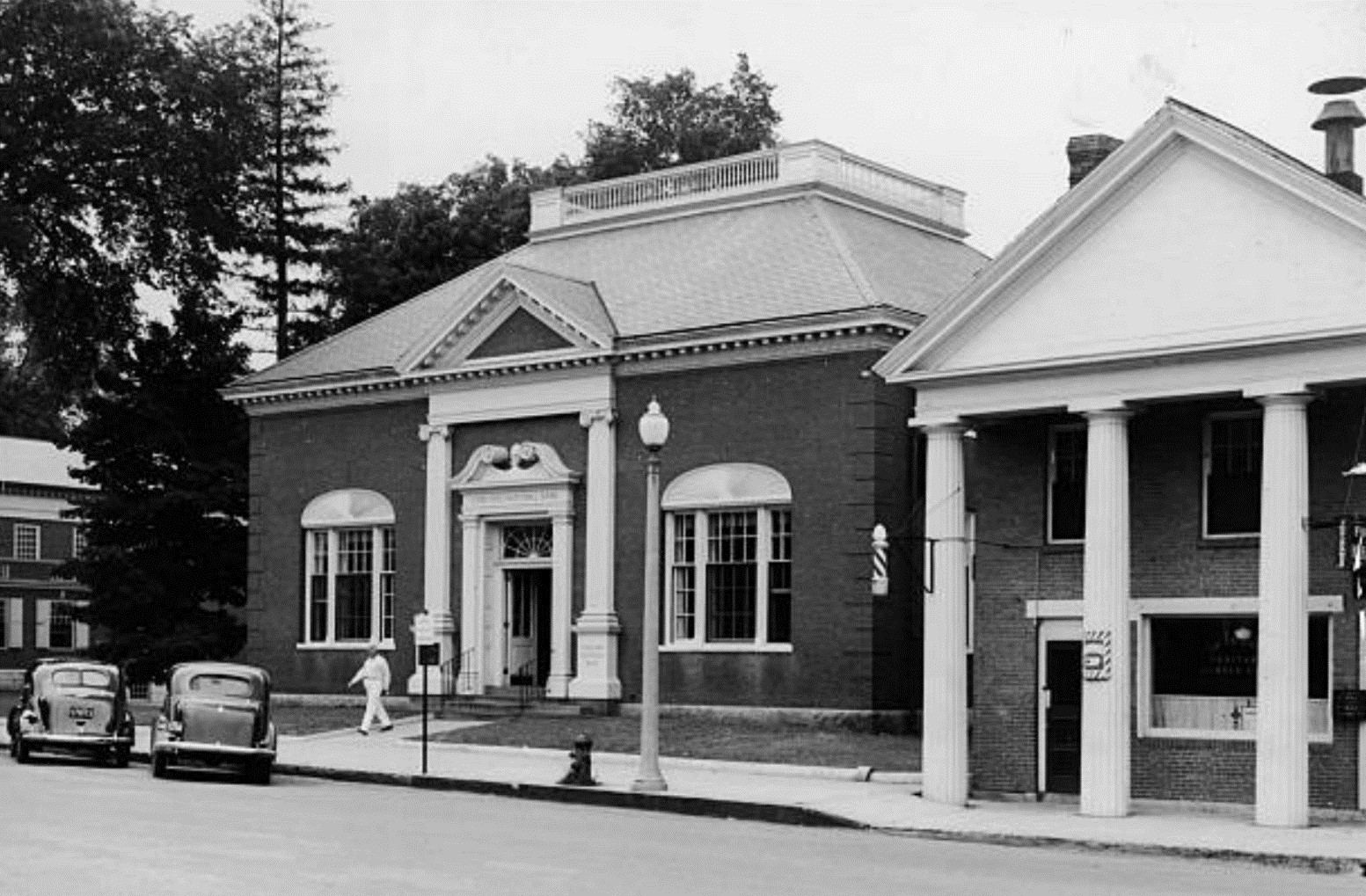
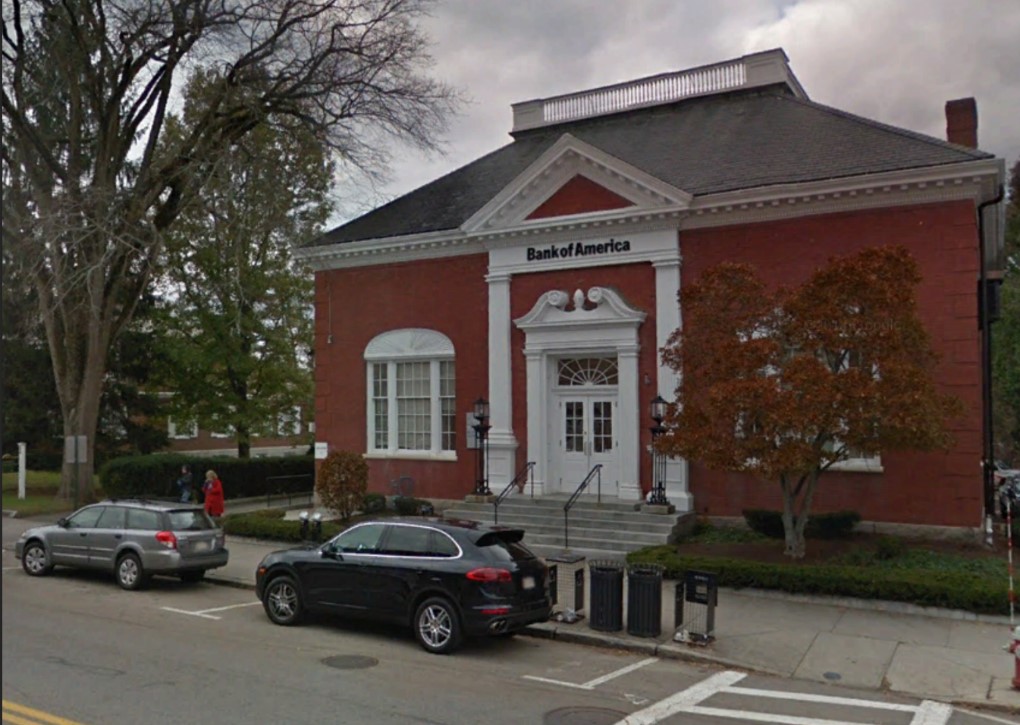
The second Concord National Bank building in the 1930s vs. today.
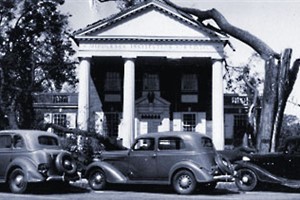
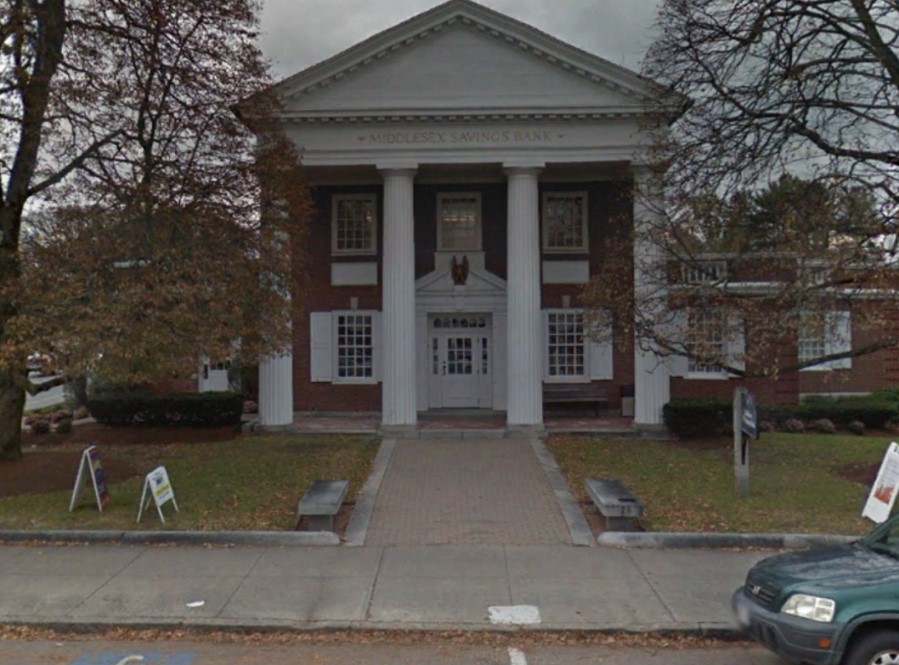
The second Middlesex Institution for Savings building in Concord, shortly after the Hurricane of 1938 vs. today.
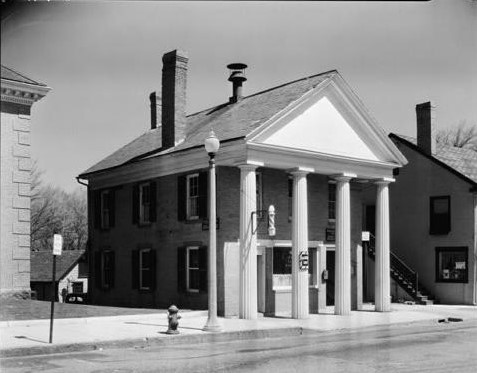
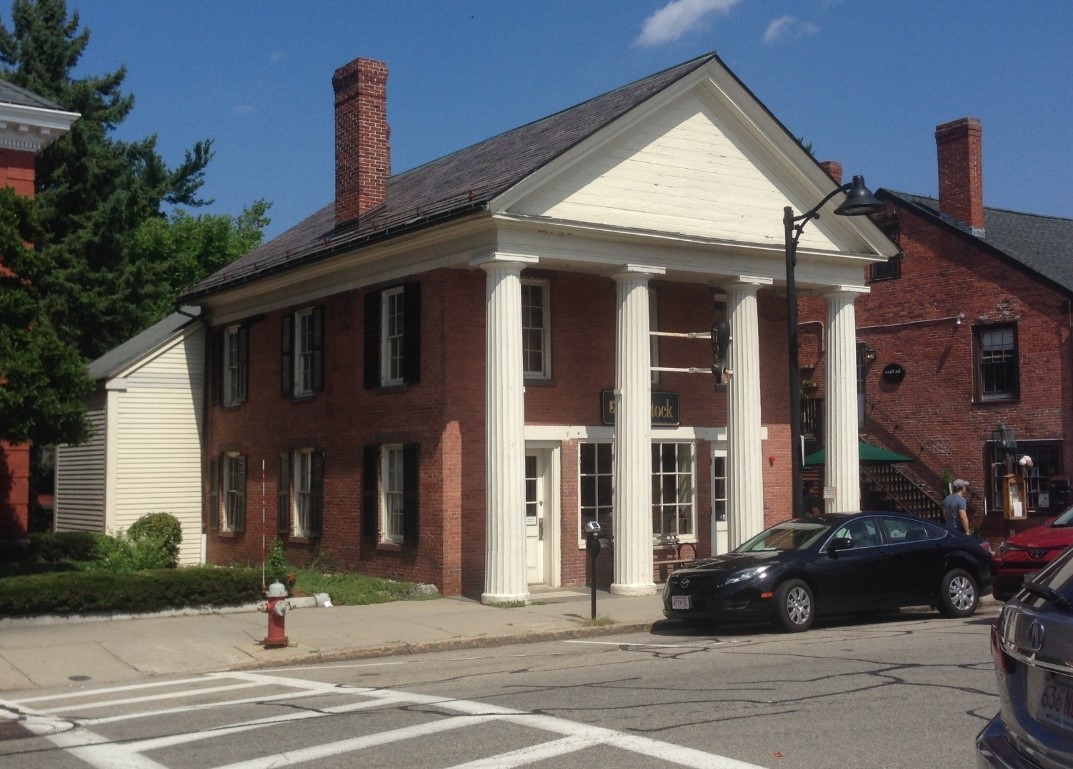
The old Concord National Bank building as a barber shop in the 1930s vs. a shoe store today.
This was a great post and a fine distraction. The primary reason I collect coins is for the history they represent. You've brought an era to life when America was still young and even localized it. Thank you for the post. Looking forward too others!



